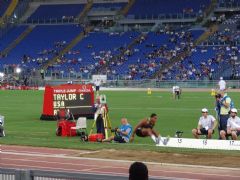My first meeting yesterday morning, stems from some reading & research I am doing in relation to movement training for my project in warm up, injury prevention & performance optimisation. I have been looking more into how dancers train, given that they are some of the most fluid & efficient movers of all athletic disciplines, with the reasoning that if more of our athletes had the co-ordination, control through range & force transference that dancers had, then we could reduce rates of injury.
Most dancing injuries fall into the category of overuse injuries, stemming more from the intensity of their performance schedules, dietary factors & the difficulty of drafting in a replacement if an individual performer is carrying an injury.
As a result, I have been collaborating on my project with my friend Mecquel, a yoga instructor, movement trainer & instructor in conditioning at the Lewis Center for the Arts, Princeton University. Mecquel has a fascinating perception on how to incorporate movement into warm-ups that is akin to mine.
Since being back in Europe, however, I have also been reading more around Gyrotonics, which was a training method I first heard about when I was studying exercise physiology at Loughborough University in 2004/5.
Gyrotonics is an exercise modality, developed by Hungarian/Romanian ballet dancer, Juliu Horvath, who also had a history as a swimmer & gymnast before dancing for the Romanian State Opera Ballet. On first impressions, the approach seems like a cross between Pilates, dance, stretching & yoga, so you can see why I have become fascinated in it.
The Gyrotonics Expansion Method, incorporates Gyrotonics, which works around a system of pulleys much like those of a Pilates reformer, & Gyrokinesis, which is performed on a stool or mat, similar to yoga. Both methods place an emphasis on breathing in harmony with fluid & continuous movement.
Where Horvath's methods vary from Pilates, is the incorporation of more rotational movements, which seek to achieve stability through balancing outward, reaching movements (extending or expanding) & movements that pull in towards the body (tensing or retracting). As a result, it seems to me that the stability achieved is far more functional when considered in relation to the skill sets executed by soccer, American football or basketball players etc, which demand such stability during complex, multi-planar & dynamic movements.
Rome's White Cloud Studio is home to a number of Gyrotonics instructors that have trained from backgrounds as diverse as athletics, dance, engineering, gymnastics, physiotherapy & osteopathy. Consequently, the practitioners share different approaches to a common discipline & the energy in the room is really vibrant.
I met contemporary dancer & Gyrotonics instructor, Martina Malvasi, who spent an hour walking & talking me through the work that was going on all around me. Martina, like so many of the other instructors "found" Gyrotonics in an effort to rehabilitate from an injury her doctor was telling her would probably end her career & she should subsequently just "rest". Like so many doctors not involved in elite performance, the lack of understanding that a sedentary approach is so toxic to injury rehabilitation was apparent & Martina was compelled to find another path. Over 10 years later, Martina is still dancing, after slowly building up her activity levels with a combination of physiotherapy, osteopathy & Gyrotonics.
Next week, I am travelling to Milan, to the main studio there & hope to spend some more time learning about the method, whilst also trying it out for myself.
Yesterday evening, I then took a step back in time & met up with many athletes, coaches & managers I had worked with in athletics who were in town for the Diamond League. After a couple of meetings in the event hotel, I went down to the Stadio Olympico & what has to be the most dramatic warm-up track on the circuit.
Whilst I moved on from athletics at the right time for my career, with those I learnt so much from moving on to new challenges, I still enjoy the environment of the warm up track at a big meet & always get new ideas from watching the various warm up routines that athletes from different disciplines adopt.
From a British perspective there were some great performances for Adam Gemili (coached by Steve Fudge) in the men's 100m & Eilidh Child (coached by Malcolm Arnold) in the women's 400m hurdles, whilst the men's high jump competition illustrated just what a strong event that is at the moment, with Mutaz Essa Barshim beating Bohdan Bondarenko on count back with a meet, national & personal best of 2m41.
Now I head off to have a weekend's respite at my friend, Miriam's home in the Umbrian countryside, before embarking on a big week of fact finding in Milan on Monday.

